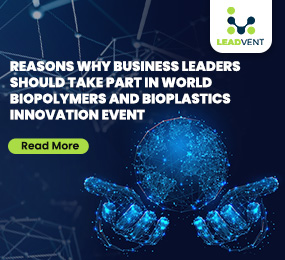The Role of Bioplastics in the Packaging Circular Economy
Public attention toward plastic waste and its negative environmental impacts has led to engagement toward sustainable alternative materials. The packaging industry finds fortunate solutions in bioplastics, which manufactories create from renewable natural materials, including corn starch along with sugarcane and algae. They serve as fundamental elements for remaking traditional linear systems into circular economy models, which reduce fossil fuel needs and solve plastic pollution challenges.
The European Bioplastics Conference 2025 is about the environmental importance of bioplastics as packaging components within circular economic frameworks. The polymers and plastics event will unite industry professionals and business leaders along with policymakers to discuss sustainable future strategies and innovative approaches while exploring regulatory frameworks.
Understanding Bioplastics and Their Impact
The main subtypes within the bioplastics classification are divided into two distinct classification groups.
- Biodegradable bioplastics: Bioplastics, including polylactic acid and polyhydroxyalkanoates, inherently crack down when exposed to composting conditions.
- Bio-based but non-biodegradable bioplastics: The manufacturing industry completes bio-PE and bio-PP from renewable materials that hold equivalent material characteristics as conventional plastic products while utilising ecologically friendly resources.
Key Advantages of Bioplastics
- Reduced Carbon Footprint - The avoidance of up to 75% less carbon is a key advantage of selecting bioplastics over traditional petroleum-based plastics.
- Less Dependence on Fossil Fuels - The consumption of crude oil declines when renewable materials reserve the required resources for bioplastic production.
- Improved Waste Management - Bioplastic materials are thrashed through composting processes, which lowers waste volume in the trash yard as well as environmental pollution in the oceans.
Bioplastics in the Circular Economy
The circular economy works through continuous material reuse to reduce waste in each production cycle. The circular economy benefits from bioplastic packaging solutions because bioplastics enable recycling together with composting processes.
How Bioplastics Fit into the Circular Economy
- Sustainable Sourcing—The utilization of plant-based materials in manufacturing cuts back dependency on petroleum products as primary resources.
- Recyclability and Compostability—Bioplastics demonstrate dual functionality as entities that either function in recycling streams or decompose through composting, which minimises the growth of waste deposits.
- Energy Efficiency—Companies need less energy to produce bioplastics than they would need to produce conventional plastics during manufacturing processes.
Case Study: Coca-Cola’s PlantBottle Initiative
The PlantBottle initiative by Coca-Cola provides the market with fully recyclable PET plastic bottles constructed from plant-based components reaching 30% of their total composition. This program shows bio-based plastics joining recycling networks to achieve the benefits of recycling capability and environmental improvement.
Challenges Facing Bioplastics Adoption
Several obstacles hinder the widespread implementation of bioplastics despite their positive features.
- Cost Barriers: The manufacturing expenses of bioplastics remain elevated as compared to ordinary plastic costs.
- Lack of Industrial Composting Facilities: Even though several bioplastics enable composting their plastic materials, numerous regions lack available composting facilities to handle bioplastics.
- Consumer Awareness and Misconceptions: Bioplastics receive common misconceptions about their biodegradability even though not every bioplastic product exists in its decomposable form.
The European Bioplastics Conference 2025 Functions as a Vital Platform
The European Bioplastics Conference 2025 stands as the highly considered polymers and plastics affair, which connects global industry leaders, policymakers, researchers, and businesses to discuss sustainable plastics products. This conference functions as the leading industry platform to tackle essential matters that arise from bioplastics sector development.
Key Highlights of the Event:
- Experts at this Plastic recycling event will reveal advanced techniques regarding sustainable polymer development and plastic recycling, which improve circular economic practices.
- Attendees will learn about advancing market patterns in bioplastics through the event, which reveals both new business propositions and market consumer trends.
- Policymakers from government institutions will present regulations that support sustainable plastic transitions along with requirements for extended producer responsibility (EPR) and global sustainability targets.
- The conference will create specific venues that allow businesses to connect with industry executives and research entities for establishing substantial bioplastic adoption programs through strategic partnerships.
- Participation in the European Bioplastics Conference 2025 allows stakeholders to acquire essential insights besides discovering new solutions and helps develop sustainable developments for polymers and plastics.
Advancing Recycling Efforts with Bioplastics
The plastic recycling event industry makes progressive changes to integrate bioplastics. Researchers, together with companies, have established new methods to efficiently separate and process bio-based plastics through their research and development activities. Worldwide events about polymers and plastics are dedicated to developing better recycling methods for circular economy system improvements.
Case Study: Commitment of Nestlé to Sustainable Packaging
The packaging division of Nestle has committed to transforming all its products from non-recyclable to reusable or recyclable before 2025. The company dedicates financial resources to bio-based alternative development while teaming up with waste management organizations to build better recycling facilities.
FAQs
Q1: Are bioplastics completely biodegradable?
Not all bioplastics display biodegradable properties. Bio-PE falls under the category of bioplastics identical to conventional plastics because they need regular plastic recycling processes.
Q2: Which environmental factors help bioplastics combat plastic contaminations?
Bioplastics solve the concern about lasting waste buildup using renewable plastic materials that can biodegrade.
Q3: Will bioplastics fulfil their role as total replacements for conventional plastics?
Bioplastics function best among modern recycling infrastructure and waste management approaches instead of functioning as an absolute plastic material replacement.
Conclusion
Bioplastics serve as essential components for the packaging circular economy as they help decrease plastic waste alongside environmental consequences. The future expansion of sustainable packaging solutions depends on bioplastics through technological advancement partnerships between industries and better recycling methods.
Stakeholders benefit from platform interactions at the European Bioplastics Conference 2025 and plastic recycling events to develop sustainable methods in the polymers and plastics event industry.







